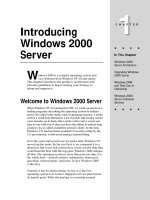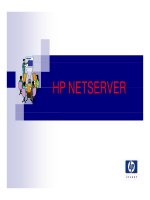Tài liệu Beginning Hibernate 2nd Edition doc
Bạn đang xem bản rút gọn của tài liệu. Xem và tải ngay bản đầy đủ của tài liệu tại đây (9.59 MB, 401 trang )
Linwood
Minter
SECOND
EDITION
Hibernate
Companion
eBook
Available
Beginning
this print for content only—size & color not accurate
CYAN
MAGENTA
YELLOW
BLACK
PANTONE 123 C
BOOKS FOR PROFESSIONALS BY PROFESSIONALS
®
US $44.99
Shelve in:
Programming Languages/Java
User level:
Beginner-Intermediate
Dave Minter, Author of
Beginning Spring 2
Coauthor of
Beginning Hibernate,
1st Edition
Building Portals with the
Java
TM
Portlet API
Pro Hibernate 3
THE APRESS ROADMAP
The Definitive Guide
to Terracotta
Spring Persistence
with Hibernate
Hibernate
Recipes
Spring Enterprise
Framework
Beginning
Hibernate
www.apress.com
SOURCE CODE ONLINE
Companion eBook
See last page for details
on $10 eBook version
ISBN 978-1-4302-2850-9
9 781430 228509
5 44 9 9
Jeff Linwood, Coauthor of
Beginning Hibernate,
1st Edition
Professional Struts
Applications
Building Portals with the
Java
TM
Portlet API
Pro Hibernate 3
Beginning Hibernate
Dear Reader,
Hibernate 3.5 lets you save normal Java™ objects into a relational database,
and retrieve them without having to write a line of SQL. It makes database per-
sistence as natural to use as other Java™ libraries. More and more companies
are using Hibernate in their systems. In our view, this trend is inevitable and
unstoppable—once you have successfully shipped a project with Hibernate,
there is no going back. Hibernate’s support for and influence over the JPA™
2 specification gives it tremendous credibility in any organization that prefers
standards to proprietary solutions.
Beginning Hibernate, Second Edition is your introduction to this wonderful
world of database persistence. Our aim is to give you a firm understanding of
the basic features of Hibernate, such as annotating your Plain Old Java Objects
and querying databases. With this understanding of the fundamental features,
you will then be in a great position to take advantage of the more advanced or
obscure features that we discuss in later chapters and appendixes, including
the use of the Hibernate plug-ins for Eclipse and Ant, execution of advanced
queries, and the integration of Hibernate with the Spring API.
Hibernate is definitely a great product, but it is not a simple one. We take a
pragmatic view of the benefits of tools, and we believe that the best way to learn
any new tool is to use it. To that end, we have provided lots of simple work-
ing examples of all the features we describe. We believe that you will find in
this book everything that you need to build a fully functional Hibernate-based
application, and to become a Hibernate aficionado.
We congratulate you on your choice of Hibernate, and wish you luck in all
your endeavors.
Jeff Linwood and Dave Minter
7.5 x 9.25 spine = 0.75" 400 page count
Beginning
Hibernate
SECOND EDITION
Jeff Linwood and Dave Minter
An introduction to persistence
using Hibernate 3.5
Covers
Hibernate
3.5
THE EXPERT’S VOICE
®
IN JAVA
TM
TECHNOLOGY
Covers
Hilbernate 3.5
www.it-ebooks.info
www.it-ebooks.info
Beginning Hibernate
Second Edition
■ ■ ■
Jeff Linwood and Dave Minter
www.it-ebooks.info
Beginning Hibernate, Second Edition
Copyright © 2010 by Jeff Linwood and Dave Minter
All rights reserved. No part of this work may be reproduced or transmitted in any form or by any means,
electronic or mechanical, including photocopying, recording, or by any information storage or retrieval
system, without the prior written permission of the copyright owner and the publisher.
ISBN-13 (pbk): 978-1-4302-2850-9
ISBN-13 (electronic): 978-1-4302-2851-6
Printed and bound in the United States of America 9 8 7 6 5 4 3 2 1
Trademarked names may appear in this book. Rather than use a trademark symbol with every
occurrence of a trademarked name, we use the names only in an editorial fashion and to the benefit of
the trademark owner, with no intention of infringement of the trademark.
President and Publisher: Paul Manning
Lead Editor: Jonathan Gennick
Technical Reviewer: Sumit Pal
Editorial Board: Clay Andres, Steve Anglin, Mark Beckner, Ewan Buckingham, Gary Cornell,
Jonathan Gennick, Jonathan Hassell, Michelle Lowman, Matthew Moodie, Duncan Parkes,
Jeffrey Pepper, Frank Pohlmann, Douglas Pundick, Ben Renow-Clarke, Dominic Shakeshaft,
Matt Wade, Tom Welsh
Coordinating Editor: Debra Kelly
Copy Editor: Sharon Terdeman
Production Support: Patrick Cunningham
Indexer: BIM Indexing & Proofreading Services
Artist: April Milne
Cover Designer: Anna Ishchenko
Distributed to the book trade worldwide by Springer-Verlag New York, Inc., 233 Spring Street, 6th Floor,
New York, NY 10013. Phone 1-800-SPRINGER, fax 201-348-4505, e-mail , or
visit www.springeronline.com.
For information on translations, please e-mail , or visit www.apress.com.
Apress and friends of ED books may be purchased in bulk for academic, corporate, or promotional use.
eBook versions and licenses are also available for most titles. For more information, reference our
Special Bulk Sales–eBook Licensing web page at www.apress.com/info/bulksales.
The information in this book is distributed on an “as is” basis, without warranty. Although every
precaution has been taken in the preparation of this work, neither the author(s) nor Apress shall have
any liability to any person or entity with respect to any loss or damage caused or alleged to be caused
directly or indirectly by the information contained in this work.
The source code for this book is available to readers at www.apress.com.
www.it-ebooks.info
iii
Contents at a Glance
About the Authors xv
About the Technical Reviewer xvi
Acknowledgments xvii
Introduction xviii
■Chapter 1: An Introduction to Hibernate 3.5 1
■Chapter 2: Integrating and Configuring Hibernate 9
■Chapter 3: Building a Simple Application 27
■Chapter 4: The Persistence Life Cycle 61
■Chapter 5: An Overview of Mapping 77
■Chapter 6: Mapping with Annotations 91
■Chapter 7: Creating Mappings with Hibernate XML Files 133
■Chapter 8: Using the Session 177
■Chapter 9: Searches and Queries 193
■Chapter 10: Advanced Queries Using Criteria 215
■Chapter 11: Filtering the Results of Searches 227
■Chapter 12: Case Study – Using Hibernate with an Existing Database 235
www.it-ebooks.info
■ CONTENTS AT A GLANCE
iv
■Appendix A: More Advanced Features 263
■Appendix B: Hibernate Tools 287
■Appendix C: Hibernate and Spring 327
■Appendix D: Upgrading from Hibernate 2 337
Index 343
www.it-ebooks.info
v
Contents
About the Authors xv
About the Technical Reviewer xvi
Acknowledgments xvii
Introduction xviii
■Chapter 1: An Introduction to Hibernate 3.5 1
Plain Old Java Objects (POJOs) 1
Origins of Hibernate and Object-Relational Mapping 3
Hibernate As a Persistence Solution 4
A Hibernate Hello World Example 5
Mappings 6
Summary 7
■Chapter 2: Integrating and Configuring Hibernate 9
The Steps Needed to Integrate and Configure Hibernate 9
Understanding Where Hibernate Fits in Your Java Application 10
Deploying Hibernate 11
Required Libraries for Running Hibernate 3.5 11
JMX and Hibernate 12
www.it-ebooks.info
■ CONTENTS
vi
Hibernate Configuration 12
Hibernate Properties 14
XML Configuration 18
Annotated Classes 19
Naming Strategy 20
Using a Container-Managed Data Source 21
The Session Factory 21
SQL Dialects 22
Summary 25
■Chapter 3: Building a Simple Application 27
Installing the Tools 27
Hibernate and Hibernate Tools 27
Simple Logging Facade for Java (SLF4J) 1.5.11 28
HSQLDB 2.0.0 28
Ant 1.8.0 29
The Ant Tasks 32
Creating a Hibernate Configuration File 33
Running the Message Example 35
Persisting Multiple Objects 38
Creating Persistence Classes 39
Creating the Object Mappings 42
Creating the Tables 48
Sessions 50
The Session and Related Objects 50
Using the Session 52
The Example Client 54
Summary 59
www.it-ebooks.info
■ CONTENTS
vii
■Chapter 4: The Persistence Life Cycle 61
Introduction to the Life Cycle 61
Entities, Classes, and Names 62
Identifiers 63
Entities and Associations 63
Saving Entities 67
Object Equality and Identity 68
Loading Entities 69
Refreshing Entities 70
Updating Entities 71
Deleting Entities 72
Cascading Operations 72
Lazy Loading, Proxies, and Collection Wrappers 74
Querying Objects 75
Summary 75
■Chapter 5: An Overview of Mapping 77
Why Mapping Cannot Be Automated 78
Primary Keys 80
Lazy Loading 82
Associations 82
The One-to-One Association 84
The One-to-Many and Many-to-One Association 86
The Many-to-Many Association 88
Applying Mappings to Associations 89
www.it-ebooks.info
■ CONTENTS
viii
Other Information Represented in Mappings 89
Specification of (Database) Column Types and Sizes 89
The Mapping of Inheritance Relationships to the Database 89
Primary Key 90
The Use of SQL Formula–Based Properties 90
Mandatory and Unique Constraints 90
Cascading of Operations 90
Summary 90
■Chapter 6: Mapping with Annotations 91
Creating Hibernate Mappings with Annotations 91
Cons of Annotations 91
Pros of Annotations 91
Choosing Which to Use 93
Using Annotations in Your Application 93
JPA 2 Persistence Annotations 93
Entity Beans with @Entity 95
Primary Keys with @Id and @GeneratedValue 95
Generating Primary Key Values with @SequenceGenerator 97
Generating Primary Key Values with @TableGenerator 98
Compound Primary Keys with @Id, @IdClass, or @EmbeddedId 99
Database Table Mapping with @Table and @SecondaryTable 103
Persisting Basic Types with @Basic 105
Omitting Persistence with @Transient 105
Mapping Properties and Fields with @Column 106
Modeling Entity Relationships 107
Inheritance 114
Other JPA 2 Persistence Annotations 117
Ordering Collections with @OrderColumn 119
Configuring the Annotated Classes 121
www.it-ebooks.info
■ CONTENTS
ix
Hibernate 3–Specific Persistence Annotations 122
@Entity 123
Sorting Collections with @Sort 123
Applying Indexes with @Table and @Index 124
Restricting Collections with @Where 124
Alternative Key Generation Strategies with @GenericGenerator 124
Using Ant with Annotation-Based Mappings 125
Code Listings 126
Summary 131
■Chapter 7: Creating Mappings with Hibernate XML Files 133
Hibernate Types 133
Entities 133
Components 134
Values 134
The Anatomy of a Mapping File 136
The <hibernate-mapping> Element 136
The <class> Element 138
The <id> Element 141
The <property> Element 144
The <component> Element 146
The <one-to-one> Element 147
The <many-to-one> Element 149
The Collection Elements 152
Mapping Simple Classes 160
Mapping Composition 162
Mapping Other Associations 165
Mapping Collections 168
www.it-ebooks.info
■ CONTENTS
x
Mapping Inheritance Relationships 171
One Table per Concrete Class 171
One Table per Subclass 172
One Table per Class Hierarchy 174
More Exotic Mappings 175
The any Tag 175
The array Tag 176
The <dynamic-component> Element 176
Summary 176
■Chapter 8: Using the Session 177
Sessions 177
Transactions and Locking 181
Transactions 181
Locking 184
Deadlocks 185
Caching 189
Threads 191
Summary 192
■Chapter 9: Searches and Queries 193
Hibernate Query Language (HQL) 193
Syntax Basics 194
UPDATE 194
DELETE 194
INSERT 195
SELECT 195
The First Example with HQL 196
www.it-ebooks.info
■ CONTENTS
xi
Logging and Commenting the Underlying SQL 200
Logging the SQL 200
Commenting the Generated SQL 201
The from Clause and Aliases 202
The select Clause and Projection 202
Using Restrictions with HQL 203
Using Named Parameters 204
Paging Through the Result Set 205
Obtaining a Unique Result 205
Sorting Results with the order by Clause 206
Associations 206
Aggregate Methods 207
Bulk Updates and Deletes with HQL 208
Named Queries for HQL and SQL 209
Using Native SQL 211
Summary 213
■Chapter 10: Advanced Queries Using Criteria 215
Using the Criteria API 215
Using Restrictions with Criteria 215
Paging Through the Result Set 219
Obtaining a Unique Result 219
Sorting the Query’s Results 220
Associations 220
Distinct Results 221
Projections and Aggregates 221
www.it-ebooks.info
■ CONTENTS
xii
Query By Example (QBE) 223
Summary 225
■Chapter 11: Filtering the Results of Searches 227
When to Use Filters 227
Defining and Attaching Filters 228
Filters with Annotations 228
Filters with XML Mapping Documents 229
Using Filters in Your Application 229
A Basic Filtering Example 230
Summary 234
■Chapter 12: Case Study – Using Hibernate with an Existing Database 235
Setting up the Database 235
Downloading the Data 235
Understanding the Data 236
Creating the Database Schema 240
Loading the Data 242
Creating a Java Object Model 243
Creating the Admin1Code Class 244
Creating the Admin2Code Class 247
Creating the Feature Codes Class 250
Creating the Place Class 253
Configuring Hibernate 257
Building the List of High Points 259
Developing the HQL Query 259
Running the Query 260
Moving Forward with the Example 262
Summary 262
www.it-ebooks.info
■ CONTENTS
xiii
■Appendix A: More Advanced Features 263
Managed Versioning and Optimistic Locking 263
Maps 264
Limitations of Hibernate 265
Hand-Rolled SQL 266
Using a Direct Mapping 266
Using a View 267
Putting SQL into an Annotation or Mapping 269
Invoking Stored Procedures 271
Events 272
An Example Event Listener 275
Interceptors 276
An Example Interceptor 279
Overriding the Default Constructor 284
Hibernate Search 285
Summary 286
■Appendix B: Hibernate Tools 287
The Eclipse Plug-In 287
Downloading the Hibernate Tools Plug-in 288
Installing the Plug-In 288
The Boilerplate Project Configuration 291
Using the Hibernate Console 293
www.it-ebooks.info
■ CONTENTS
xiv
The Ant Tasks 313
How the Ant Tasks Work 313
Reverse Engineering 319
Templates 323
Configuring the Classpath 324
Summary 325
■Appendix C: Hibernate and Spring 327
Configuring Hibernate from a Spring Application 327
Configuring Spring 328
Using Hibernate in Your Spring Beans 330
Declarative Transaction Management 331
Managing the Session 332
The Sample Configuration File 333
Summary 336
■Appendix D: Upgrading from Hibernate 2 337
Package and DTD Changes 337
New Features and Support for Old Ones 338
Changes and Deprecated Features 339
Additions 340
Changes to Tools and Libraries 340
Changes with Java 5 341
Summary 341
Index 343
www.it-ebooks.info
xv
About the Authors
■Jeff Linwood has been involved in software programming since he had a
286 in high school. He got caught up with the Internet when he got access
to a UNIX shell account, and it has been downhill ever since.
When he’s not playing on the computer, his hobby is running
ultramarathons. Jeff is based in Austin, Texas and helps large companies
solve tough problems with content management, search engines, and web
application development. Jeff also co-authored Professional Struts
Applications (Apress), Building Portals with the Java Portlet API (Apress),
and Pro Hibernate 3 (Apress).
■Dave Minter has adored computers since he was small enough to play in
the boxes they came in. He built his first PC from discarded, faulty, and
obsolete components; and he considers that to be the foundation of his
career as an integration consultant. Dave is based in London, where he
helps large and small companies build systems that “just work.” He wrote
Beginning Spring 2: From Novice to Professional (Apress) and co-authored
Building Portals with the Java Portlet API (Apress) and Pro Hibernate 3
(Apress).
www.it-ebooks.info
xvi
About the Technical Reviewer
■Sumit Pal has about 16 years of experience with Software Architecture,
Design & Development on a variety of platforms, including Java, J2EE.
Sumit has worked in SQLServer Replication group while with Microsoft for
two years and with Oracle’s OLAP Server group while with Oracle for seven
years.
Apart from Certifications like IEEE-CSDP and J2EE Architect, Sumit
also has an MS in Computer Science from Asian Institute of Technology,
Thailand.
Sumit has keen interest in database internals, algorithms, search
engine technology, data mining, and machine learning.
Sumit has invented some basic generalized algorithms to find
divisibility between numbers and also invented divisibility rules for prime
numbers less than 100.
Sumit loves to play badminton and swim. He is also an amateur
astrophysicist and is incorporating green habits into his daily life.
www.it-ebooks.info
xvii
Acknowledgments
Jeff and Dave would like to thank the staff of Apress for their consistent good humor in the face of
looming deadlines. Particular thanks are due to Debra Kelly, our ever-present project manager, for
keeping this book on the rails; and to Patrick Meader, for correcting our dodgy spelling and grammar.
Thanks to Fran Parnell, as well, for managing the project in its early stages. Special thanks to Jonathan
Gennick for his contributions and particularly for his help directing the new edition. Thanks also to
Steve Anglin for letting us write for Apress and to Sumit Pal for his contributions as technical reviewer.
Finally, thanks are due to the Hibernate team for producing an awesome piece of software.
Jeff would like to thank Cheri for putting up with endless late nights to meet chapter deadlines; he
would also like to thank Rocky for giving him a reason to put the laptop away on a sunny day. He would
also like to thank his friends Roman and Jason for reviewing parts of the book.
www.it-ebooks.info
xviii
Introduction
Hibernate is an amazing piece of software. With a little experience and the power of annotations, you
can build a complex, database-backed system with disturbing ease. Once you have built a system using
Hibernate, you will never want to go back to the traditional approaches.
While Hibernate is incredibly powerful, it presents a steep learning curve when you first encounter
it—steep learning curves are actually a good thing because they impart profound insight once you have
scaled them. Yet gaining that insight takes some perseverance and assistance.
Our aim in this book is to help you scale that learning curve by presenting you with the minimal
requirements of a discrete Hibernate application, explaining the basis of those requirements, and
walking you through an example application built using to them. We then provide additional material to
be digested once the fundamentals are firmly understood. Throughout, we provide examples, rather
than relying upon pure discourse. We hope that you will continue to find this book useful as a reference
text long after you have become an expert on the subject.
Who This Book Is For
This book assumes a good understanding of Java fundamentals and some familiarity with database
programming using the Java Database Connectivity (JDBC) API. We don’t expect you to know anything
about Hibernate—but if you buy this book, it will probably be because you have some exposure to the
painful process of building a large database-based system.
All of our examples use open source software—primarily the Hibernate API itself—so you will not
need to purchase any software to get started with Hibernate development. This book is not an academic
text. Our focus is instead on providing extensive examples and taking a pragmatic approach to the
technology that it covers.
To true newcomers to the Hibernate API, we recommend that you read at least the first three
chapters in order before diving into the juicy subjects of later chapters. Very experienced developers or
those with experience with tools similar to Hibernate will want to skim through the latter half of the book
for interesting chapters. Readers familiar with Hibernate will want to turn to the appendixes for
discussion of more arcane topics.
How This Book Is Structured
This book is informally divided into three parts. Chapters 1 through 8 describe the fundamentals of
Hibernate, including configuration, the creation of mapping files, and the basic APIs. Chapters 9 through
11 describe the use of queries, criteria, and filters to access the persistent information in more
sophisticated ways. Chapter 12 is a case study that starts with an existing database, and then shows you
how to map that database to a Java application using Hibernate.
www.it-ebooks.info
■ INTRODUCTION
xix
Finally, the appendixes discuss features that you will use less often, or that are peripheral to the core
Hibernate functionality. The following list describes more fully the contents of each chapter:
Chapter 1 outlines the purpose of persistence tools and presents excerpts from
a simple example application to show how Hibernate can be applied. It also
introduces core terminology and concepts.
Chapter 2 discusses the fundamentals of configuring a Hibernate application. It
presents the basic architecture of Hibernate and discusses how a Hibernate
application is integrated into an application.
Chapter 3 presents the example application from Chapter 1 in its entirety,
walking you through the complete process of creating and running the
application. It then looks at a slightly more complex example and introduces
the notion of generating the database schema directly from Hibernate
annotations.
Chapter 4 covers the Hibernate life cycle in depth. It discusses the life cycle in
the context of the methods available on the core interfaces. It also introduces
key terminology and discusses the need for cascading and lazy loading.
Chapter 5 explains why mapping information must be retained by Hibernate
and demonstrates the various types of associations that can be represented by a
relational database. It briefly discusses the other information that can be
maintained within a Hibernate mapping.
Chapter 6 explains how Hibernate lets you use the annotations to represent
mapping information. It provides detailed examples for the most important
annotations, and discusses the distinctions between the standard JPA 2
annotations and the proprietary Hibernate ones.
Chapter 7 explains how the XML-based mapping files can be used to represent
mapping information in Hibernate. It provides examples for all of the most
common mapping types and reference notes for the more obscure ones.
Chapter 8 revisits the Hibernate Session object in detail, explaining the various
methods that it provides. The chapter also discusses the use of transactions,
locking, and caching, as well as how to use Hibernate in a multithreaded
environment.
Chapter 9 discusses how Hibernate can be used to make sophisticated queries
against the underlying relational database using the built-in Hibernate Query
Language (HQL).
Chapter 10 introduces the Criteria API, which is a programmatic analog of the
query language discussed in Chapter 9.
Chapter 11 discusses how the Filter API can be used to restrict the results of the
queries introduced in Chapters 9 and 10.
Chapter 12 is a case study chapter that illustrates how to use Hibernate with an
existing database. This chapter draws on topics covered in the previous 11
chapters to demonstrate a common use case.
Appendix A presents a large number of peripheral features that do not warrant
more extensive coverage in a beginner-level text. The chapter discusses the
www.it-ebooks.info
■ INTRODUCTION
xx
basics, with examples, of the support for versioning and optimistic locking, the
provision for persisting and retrieving maps of information, and some of the
obscure limitations of Hibernate and various ways that these can be worked
around. It also discusses the use of events and interceptors. The chapter briefly
touches on Hibernate Search, which bridges Lucene and Hibernate.
Appendix B discusses how the Hibernate Tools toolset can be used to enhance
development with the Eclipse development environment and the Ant build
tool. It also explains how the Ant code-generation tasks can be customized.
Appendix C discusses how Hibernate can be integrated into the Spring API. The
integration of Hibernate as the persistence layer of a Spring application is
complex, so we present a working example, including the entire bean definition
file, with discussions of the appropriate way to manage the session in the
Spring MVC environment. This chapter also discusses how Spring can enforce
the proper transactional boundaries when using Hibernate.
Appendix D discusses some topics of interest to developers who are working
with a preexisting base of code that was built using version 2 of Hibernate. We
present the various approaches for coexisting with Hibernate 3 code, as well as
for migrating a Hibernate 2 code base to the Hibernate 3 API.
Downloading the Code
The source code for this book is available to readers from www.apress.com, in the Source Code/Download
section. Please feel free to visit the Apress web site and download all the code from there.
Contacting the Authors
We welcome feedback from our readers. If you have any queries or suggestions about this book, or
technical questions about Hibernate, or if you just want to share a really good joke, you can e-mail Dave
Minter at and Jeff Linwood at
www.it-ebooks.info
C H A P T E R 1
■ ■ ■
1
An Introduction to Hibernate 3.5
Most significant development projects involve a relational database. The mainstay of most commercial
applications is the large-scale storage of ordered information, such as catalogs, customer lists, contract
details, published text, and architectural designs.
With the advent of the World Wide Web, the demand for databases has increased. Though they may
not know it, the customers of online bookshops and newspapers are using databases. Somewhere in the
guts of the application a database is being queried and a response is offered.
While the demand for such applications has grown, their creation has not become noticeably
simpler. Some standardization has occurred around the Java Persistence API with the release of
Enterprise Java Beans 3.0. Hibernate 3.5 is an implementation of the Java Persistence API standard,
which replaced older Java persistence solutions such as the entity beans from Enterprise Java Beans 2.
There are solutions for which some sort of object-relational mapping (ORM) like Hibernate is
appropriate, and some for which the traditional approach of direct access via the Java Database
Connectivity (JDBC) API is appropriate. We think that Hibernate represents a good first choice, as it does
not preclude the simultaneous use of these alternative approaches.
To illustrate some of Hibernate’s strengths, in this chapter we will show you a brief example using
Hibernate and contrast this with the traditional JDBC approach.
Plain Old Java Objects (POJOs)
In our ideal world, it would be trivial to take any Java object and persist it to the database. No special
coding would be required to achieve this, no performance penalty would ensue, and the result would be
totally portable.
In this ideal world, we would perhaps perform such an operation in a manner like that shown in
Listing 1-1.
Listing 1-1. A Rose-Tinted View of Object Persistence
POJO pojo = new POJO();
ORMSolution magic = ORMSolution.getInstance();
magic.save(pojo);
There would be no nasty surprises, no additional work to correlate the class with tables in the
database, and no performance problems.
www.it-ebooks.info
CHAPTER 1 ■ AN INTRODUCTION TO HIBERNATE 3.5
2
Hibernate comes remarkably close to this, at least when compared with the alternatives—but alas,
there are configuration files to create and subtle performance issues to consider. Hibernate does,
however, achieve its fundamental aim—it allows you to store POJOs in the database. Figure 1-1 shows
how Hibernate fits into your application between the client code and the database.
Figure 1-1. The role of Hibernate in a Java application
The common term for the direct persistence of traditional Java objects is object-relational
mapping—that is, mapping the objects in Java to the relational entities in a database.
POJOs can be any Java object at all. Hibernate allows you to persist POJOs with very few constraints.
Listing 1-2 is an example of a simple POJO to represent a message.
Listing 1-2. The POJO Used in this Chapter’s Examples
public class Message {
private Message() {
}
public Message(String messageText) {
this.messageText = messageText;
}
public String getMessageText() {
return messageText;
}
www.it-ebooks.info
CHAPTER 1 ■ AN INTRODUCTION TO HIBERNATE 3.5
3
public void setMessageText(String messageText) {
this.messageText = messageText;
}
private String messageText;
}
The sole condescension to Hibernate here is the provision of a private default constructor.
Hibernate demands that all POJOs to be stored should provide a default constructor; but even that can
be worked around when third-party classes fail to satisfy this limited requirement (we will demonstrate
this in Appendix A).
Origins of Hibernate and Object-Relational Mapping
If Hibernate is the solution, what was the problem? One answer is that doing things the right way when
using JDBC requires a considerable body of code, and careful observation of various rules (such as those
governing connection management) to ensure that your application does not leak resources. The
gargantuan body of code in Listing 1-3 is required to populate the example Motd object from the
database even when you know the appropriate message identifier.
Listing 1-3. The JDBC Approach to Retrieving the POJO
public static List getMessages(int messageId) throws MessageException {
Connection c = null;
PreparedStatement p = null;
List list = new ArrayList();
try {
Class.forName("org.postgresql.Driver");
c = DriverManager.getConnection(
"jdbc:hsqldb:testdb;shutdown=true",
"hibernate",
"hibernate");
p = c.prepareStatement(
"select message from motd");
ResultSet rs = p.executeQuery();
while(rs.next()) {
String text = rs.getString(1);
list.add(new Message(text));
}
return list;
} catch (Exception e) {
log.log(Level.SEVERE, "Could not acquire message", e);
throw new MotdException(
"Failed to retrieve message from the database.", e);
www.it-ebooks.info








![Tài liệu Beginning the Linux Command Line [Apress 2009] ppt](https://media.store123doc.com/images/document/13/ce/kn/medium_zPbk2szWHh.jpg)
